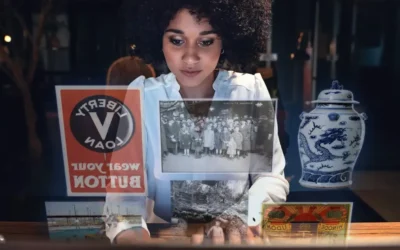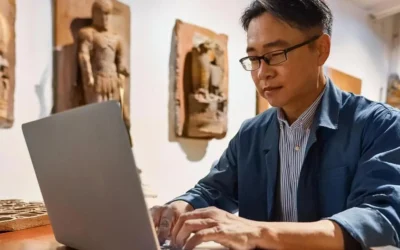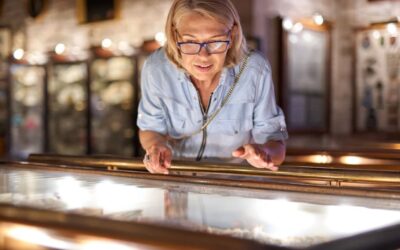Museum TrendsWatch: Education for Our Children

Rachael Cristine Woody
It’s that time of year again and the Center for the Future of Museums’ TrendsWatch report is out.
The Center for the Future of Museums (CFM) is under the auspices of American Alliance of Museums and offers a trends forecast that typically covers five topics, sometimes all related, sometimes not. This year the unifying theme is Museums as Community Infrastructure, with the identification of five pillars. The first pillar is: Education for our Children. To open this section, CFM Founding Director Elizabeth Merritt reminds us that education had its issues prior to the pandemic, and many were further exacerbated by the pandemic’s multi-year strain on children, teachers, and parents. The learning impact was particularly severe for children already not well supported and who don’t have access to the technology required for remote learning.
Museums are Already Good at This
Merritt opens this section with acknowledging that museums have long been on the forefront of innovative educational offerings and experiences. The pandemic provided an opportunity for museums to fill a gap in educational programming, and in doing so they were able to demonstrate their educational expertise. The pandemic has shifted our priorities and many of us have more highly prioritized flexibility and freedom of the where, when, and how work gets done. Merritt contends this shift is taking place in schools too. To complement this shift, museums can continue to grow in their educational offerings to supplement a more holistic approach to education.
What Museums Can Do
The core actions from this section are:
- Museums can and should create better educational experiences to help supplement and support school education programs.
- Museums can offer alternate educational pathways with museum programming in schools, or vice versa.
- Museums can help foster what Merritt defines as 21st century skills: critical thinking, problem solving, synthesis, innovation, creativity, teamwork, and collaboration.
A Framework for Action
Each TrendsWatch section includes an “Action” area. The following is a summary of those actions for this section:
- Invest in museum capacity to work with school (i.e., more staff positions).
- Develop resources from museum assets, such as curricula.
- Build leaning networks by partnering with peer institutions.
- Invest in digital offerings whether providing free wifi, teaching digital skills, create digital learning materials.
- Create permanent learning labs.
- Become a museum school: offer a home to an independent school, help students create their own museum, or start their own schools in the museum.
For more ideas, please see Reimagining Museum Engagement for Younger Generations, via Lucidea’s Think Clearly Blog.
An Evolution on Who and How Museums Deliver Education
One of the excellent takeaways from providing content remotely during a pandemic is that many museums now have the tools and know-how to create educational offerings that can be delivered remotely. This can greatly increase the number of children (and schools) the museum can support with supplemental content. Additionally, even if schools are geographically proximate, sometimes virtual delivery is preferred as it cuts down on transition time and costs, minimizes COVID exposure, etc.
Challenge to be Addressed
As is true throughout this report, this section and the “Actions” provided therein all require resources: space, staff, a CMS, and digital assets that are ready to go. This section does include “Invest in museum capacity…” as part of its recommendations; however, this is a particularly bittersweet recommendation given that museum educator positions were some of the first to be eliminated by museums as the pandemic hit.
Conclusion
For more information on what peer museums have done in this area, and for more in-depth analysis on this topic, please view the original report available via the CFM TrendsWatch website. Next week we move on to the second pillar of community infrastructure: Livable Communities for Our Elders.
Resource Links
These resources were cited in this section of the TrendsWatch report and were of particular interest:
- The seminal AAM report Building the Future of Education: Museums and the Learning Ecosystem (2014).
- Culture and Community in a Time of Crisis project, a special edition of Culture Track.

Rachael Cristine Woody
Rachael Cristine Woody advises on museum strategies, digital museums, collections management, and grant writing for a wide variety of clients. In addition to several titles published by Lucidea Press, she is a regular contributor to the Think Clearly blog and an always popular presenter. And remember to check out Lucidea’s Argus solution for powerful and innovative museum collections management.
Never miss another post. Subscribe today!
Similar Posts
How Archives Can Enrich Museum Collections Online
Staffed archives are in constant motion in their attempt to provide and broaden access to the archival collections.
How to Enhance Museum Collections Online with New Information
One of the wonderful things about museums is that the learning never stops. There are always projects, exhibits, and programs in development that serve as constant instigators of research.
How to Enhance the Museum Object Record with Immediately Available Information
This month’s series focuses on the enhancement of museum object data using “hidden” troves of information. Hidden is in quotes because the information exists and often is not hidden—it just hasn’t been gathered for inclusion in the museum Collections Management System (CMS).
Where the Gaps Live with Traditional Museum Object Cataloging
Standard museum cataloging leverages the usual set of fields that are considered best practice. We tend to refer to this information as “the tombstone information,” meaning it is clear and concise in communicating the “need to know” information.




Leave a Comment
Comments are reviewed and must adhere to our comments policy.
0 Comments